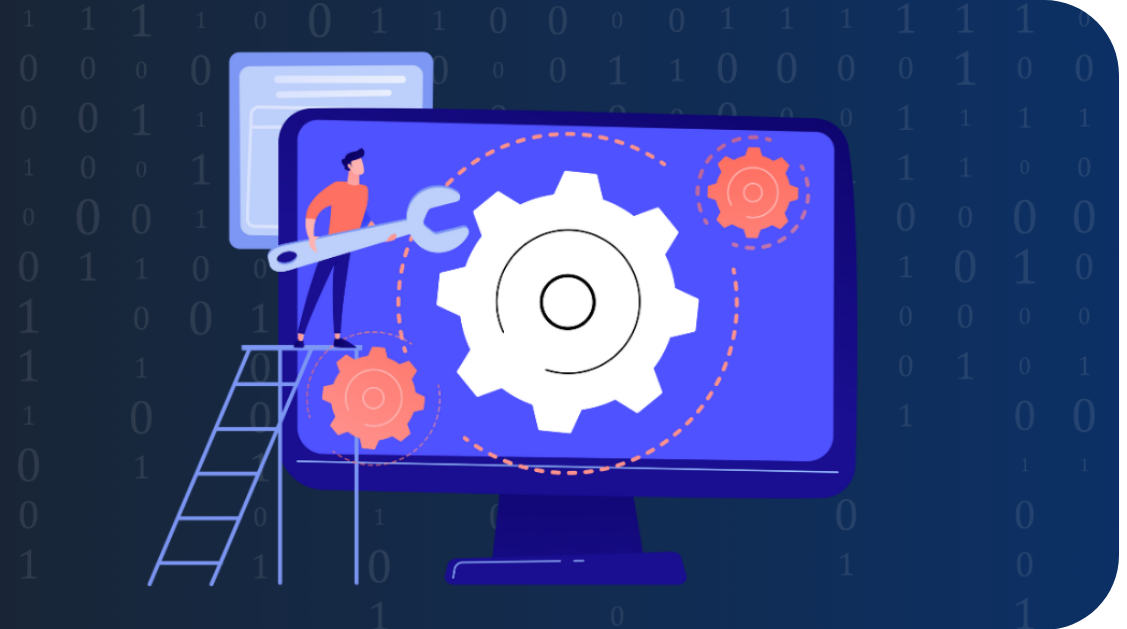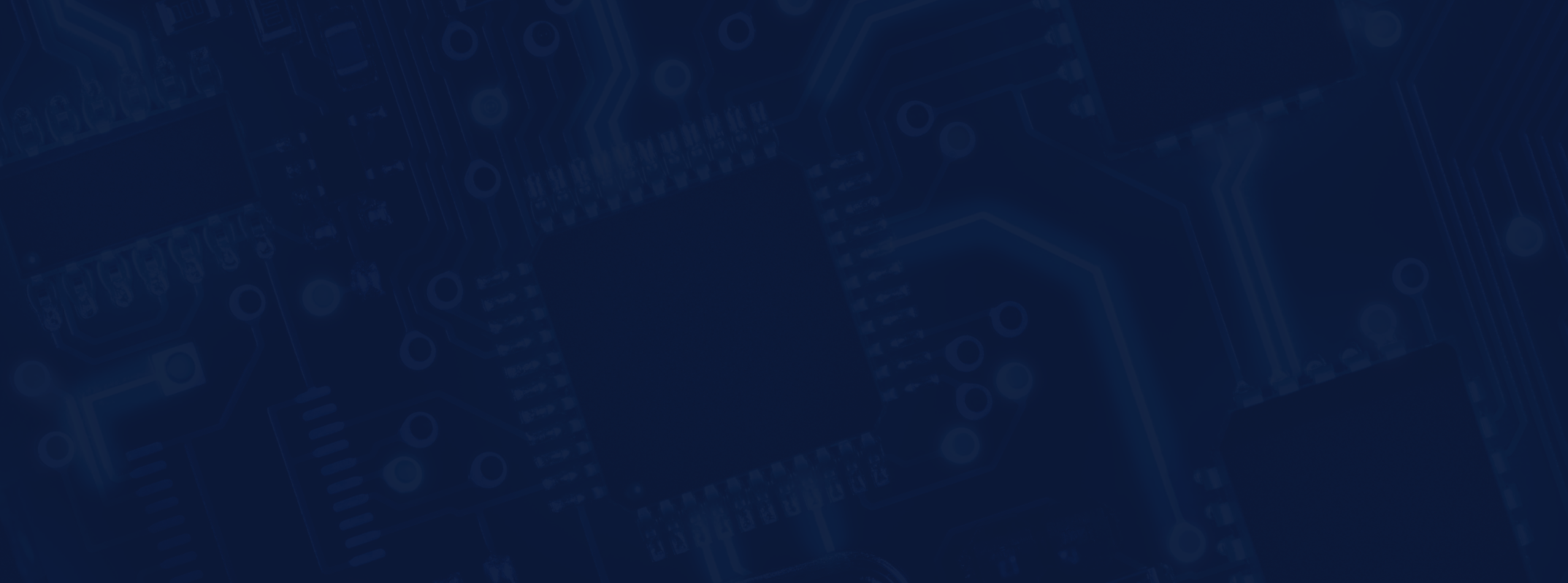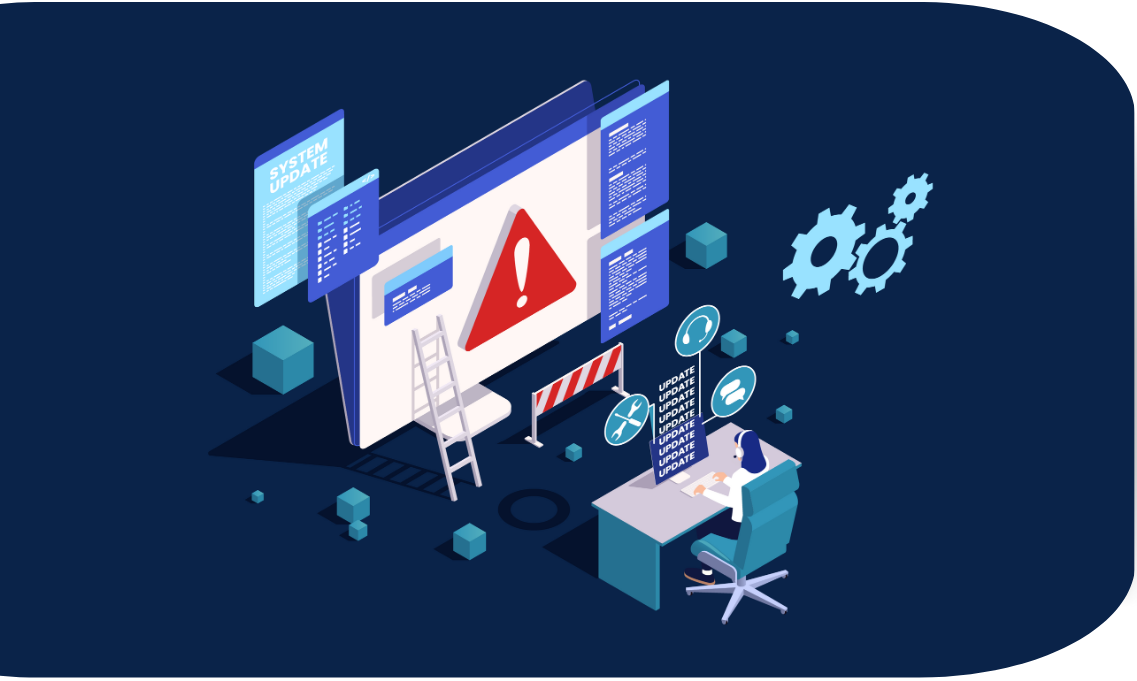Software Maintenance is like gardening the digital landscape; negligence leads to chaos while nurturing fosters a flourishing ecosystem.
If software is a medium through which you connect with your customers, then you must pay attention to Software Maintenance. Up-to-date software with no performance issues and on-time catering to customers’ needs always wins users' hearts.

What is Software Maintenance?
Software Maintenance is one of the continuous and in-demand processes of the software development life cycle. It ensures modifying, upgrading, or altering the software to enhance performance, meet current Software trends, rectify bugs, re-engineering, documentation, and porting & migration.
It also means that Software Maintenance is a continuous process, unlike development and deployment. It’s an ongoing process because new feature(s) will continually be added. And with that, there might be chances of bugs as well. Therefore, knowing about software maintenance and everything revolving around it is important.
What is the Objective of Software Maintenance
Software Maintenance is always undertaken after identifying several bugs or performance issues. It can even be performed when you want to introduce new features to benefit its users. Apart from this, there are seven types of Software Maintenance, which are as follows:
Enhance User Experience
Software maintenance is also performed when new features or functionalities are introduced. This happens when ensuring the user stays engaged with and keeps using the software.

Security Updates
Security becomes a top priority when it comes to software maintenance. Users look up to software with which they can share their credentials. Therefore, preventing malware attacks and keeping software reliable for users is one of the core objectives of software maintenance.

Achieve High User Satisfaction
Another objective of maintaining software is to offer high-end and hassle-free performance. Besides, the software should not make the user suffer; it should swiftly cater to the user’s request.

Increase Software Longevity
Since you have heavily invested in software development, it has to run for a long time and cater to user requirements without hassle. The longer software remains in the market, the better you can maximize the return on investment.

Emergency Maintenance
As the name suggests, Maintenance is performed when there is a critical issue that not only hampers user experience but could even fail your Software miserably. Emergency Maintenance restores software to normal operations, eliminating all users' challenges.

Regulatory Compliance
Software needs to abide by regulatory standards & guidelines. This maintenance list ensures your software complies with all the regulatory compliance requirements. Software that strictly adheres to standards always performs well and has a high user abandon ratio.

Comply with Regulatory Norms
One of the core objectives of software maintenance is to comply with legal and regulatory standards so that users feel secure sharing their credentials.
9 Challenges of Software Maintenance
Once you are well-acquainted with the meaning and objective of software maintenance, you must take advantage of challenges.
- Difficulty in Understanding the Initial Code
- Obsolete Systems
- Scope Expansion
- Dependency Management
- Unpredictable Environments
- Lack of Resources
- Coping Up with Business Requirements
- Technical Debt
- Following Maintenance Routine
A new developer often needs help understanding another developer's original code. On top of it, if the original code needs to be better written, it will definitely create confusion and errors. All these make the software maintenance process time and manpower-consuming.
Another challenge on the list is maintaining software built on obsolete technologies. Because the original developer who created the software back then might no longer be available, the new developer needs to understand first and then overcome the ongoing challenges with new-age solutions.
New features will always be added, resulting in scope expansion. But it can even make software maintenance challenging since it increases the complexity of your software. And this leads to unnecessary wastage of resources, which is not acceptable at the stage when your software is already available for public use.
Since multiple third-party libraries, frameworks, and components are involved in the software, keeping all the dependencies compatible becomes challenging.
Software is made to work in different environments, hardware systems, operating systems, and configurations. The challenge is ensuring stability and compatibility across different environments, which is quite time-consuming.
Not only manpower but budget and time are also crucial factors in maintaining software. Since there are development priorities, managing everything at a time becomes difficult.
Adapting and integrating new business trends and maintaining software built with old technology can be challenging since it will require understanding the software's technicalities.
It is an accumulation of neglected bugs and errors over time. It becomes challenging to overcome the tech debt while also maintaining the software development.
Addressing high-priority issues and maintaining corrective, adaptive, or perfective maintenance simultaneously is one of the challenges of software maintenance.
4 Types of Software Maintenance
Corrective Maintenance
A reactive approach toward fixing bugs and defects (identified post-software deployment or in a live environment) is called corrective Maintenance. This reactive measure aims to make the Software function smoothly and cater to customers’ demands without hassle.
This ensures the correction of software defects, bugs, and errors. Corrective maintenance can be performed when:
- Software failure due to faults, negligence, invalid code, or tests
- tests Bugs notification by users
Perfective Maintenance
When there is a dire need for new features, or your Software is overloaded with unwanted or obsolete features, it becomes necessary to implement perfective Maintenance. Following this Maintenance process helps to make Software smooth and enhance user experience.
Perfective maintenance ensures:
- Identifying and resolving bugs to prevent catastrophic events
- Strengthening security and overcoming challenges
- Providing user support whenever required
Adaptive Maintenance
Adaptive Maintenance becomes helpful in meeting customers’ demands and changing business requirements, best practices, operating systems, or technologies. Once the Maintenance is performed, it is checked whether or not being compatible and operational with the new environment.
Adaptive Maintenance aims to alter when:
- Come across evolving operating systems due to newer technologies, legal regulations, rules, and policies.
- Demand from end users for new products or software
- Already predicted the potential software threat or vulnerability
Preventive Maintenance
Contrary to Corrective Maintenance (reactive approach), this is a proactive approach to Software Maintenance. Instead of panicking when something goes wrong, Preventive Maintenance detects and prevents bugs and defects from happening. As a result, there will never be Software downtime, and users will access your Software without any trouble.
Besides, there will be:
- Increase in lifespan of the machinery and reduced maintenance cost
- Improvement in maintenance activities
- Business sustainability and elimination of catastrophic events
What is the Process of Software Maintenance/7 Phases of Software Maintenance (Phases of SMLC)
Software Maintenance is one of the crucial phases of the software development life cycle (SDLC). Like the entire SDLC, even software maintenance has a life cycle called software maintenance life cycle (SMLC).
- Phase 1: Finding Out Software Maintenance Requests
- Phase 2: Analysis of Maintenance Request
- Phase 3: Design of Replacement Model
- Phase 4: Executing the Required Changes
- Phase 5: Testing the Changes
- Phase 6: Performing Acceptance Testing
- Phase 7: Delivering the Software
The foremost phase of the software maintenance life cycle is identifying the maintenance requirement. The process is automated and manual, meaning you can run logs or sort out user error messages to make a list of the maintenance requirements. But before doing so, each maintenance requirement is individually analyzed to set priorities.
Standard operating procedures define the responsibilities needed to execute a particular task. For automation, there should be clear and defined steps to transform the process from the age-old concept digitally.
The design phase begins once the analysis phase is completed and ready with the maintenance requirement as per the priority. The modules or new frameworks are prepared. Besides, test cases are also created to ensure the safety and security of the newly designed model.
This is the execution phase where a new framework is added, new features are added, and newly written code is processed. Considering the structure design prepared in the design phase, all the new models are coded accordingly.
Now that new changes are made, regression testing is performed to inspect for bugs, errors, and defects. Post-regression testing, it is also ensured that there is no new flaw detected in the modified software.
This phase involves third-party users. It happens with dummy testing to identify if the modified system works properly.
Lastly, it’s time to deliver the software to the client when everything works swiftly and smoothly.
8 Benefits of Software Maintenance
When it comes to understanding every aspect of software maintenance, why neglect its advantages? Because this section makes you familiar with some crucial benefits that one must pay attention to.
Qualitative Software
One of the biggest perks of regular software maintenance is it keeps your software glitch-free, reliable, and efficient. Not only does it meet your users’ expectations, but it also ensures software functions smoothly.
Upgraded Security
Regular maintenance frees your software from potential threats, security vulnerabilities, and malware attacks. The maintenance is conducted through patches and security updates.
High-end User Satisfaction
Another benefit software maintenance brings to the table is delivering high-end user satisfaction. When the software is regularly maintained, your user will not face any challenges. Plus, they will be delighted with the quick service you offer via software, leading to a sense of satisfaction.
Longevity
The longevity depends on how frequently you perform software maintenance. A maintained software lasts longer than the flawed one. It is advisable to perform software maintenance at regular intervals for best performance.
Cope Up With Business Trends
Business trends keep changing, and coping with them becomes a dire need. With regular software maintenance, your business remains aligned with the changing requirements of the user. And when the software successfully meets expectations, the chances of customer retention increase.
Eliminates Downtime
System failures or performance issues cause downtime. But with software maintenance, downtime will be a thing of the past. This leads to businesses serving the customers’ needs without complaints and welcoming even new customers.
Scalable Applications
When you keep a regular software maintenance schedule, handling huge traffic will never be a concern. The software itself scales up and down as and when required.
Bug-Free Software
You name it objective or benefit, but software maintenance is always performed to make the software bug-free. A smooth-running software always wins the hearts of users.
Factors Affecting Software Maintenance Cost
When choosing process automation, you must know how much it will benefit you and your business. Let’s look at all possible business benefits.
Technical Factors
The technical factors discuss more or less software maintenance from the core concepts, which are:
Programming Languages Selection
Software built with high-level programming language is easier to maintain and understand than one built using low-level languages. This needs to be kept in mind that programming languages play a crucial role in defining software maintenance costs.
Programming Style
Another factor determining software maintenance cost is the programming style. It includes how developers write the code, which decides the learning curve of the software and, subsequently, the updating and understanding of the software.
Validation & Testing
It is said that the more time spent defining and testing the design, the fewer the chances of bug detection, lowering software maintenance costs because the type and complexity of bugs determine the cost.
Configuration Management & Techniques
Keeping configuration management techniques intact can save much money in software maintenance. But for this, you must maintain uniformity in system documentation.
Module Independence
This means the capacity to resolve even complex software problems without affecting other parts of the website or application.
Documentation
One of the technical factors contributing to lowering your software maintenance cost is properly documenting your software’s development.
Non-Technical Factors
External Environment Dependencies
What can shoot up the software maintenance cost mostly depends on the external environments and not adapting to the changes. The software maintenance cost will be lower if you keep updated with the external environment modifications.
Lifecycle of Software
Every software has a lifecycle, and obsolete ones require hardware change. As a result, the conversion costs remain above the rewriting cost.
Team Stability
A new custom software development team member can take a while to cope with the development process. And the more time it takes, the higher the software development cost.
Hardware Stability
Hardware plays a crucial role in developing software. There will be zero software maintenance costs if the software remains steady on the single hardware throughout its lifecycle.
The maintenance process may take away 60-70% of your development cost had it been built with obsolete technology, resulting in developers facing challenges in finding defects or bugs.
But the software maintenance cost can be lower by following several factors:
- Abiding by transparent development processes
- Adhering to programming principles
- Documenting everything
- Hiring experienced software developers
- Resolving tech debt
These basic factors help in lowering software maintenance costs to a greater extent.
Let us show you how mobile application software maintenance costing works:
- Firstly, an application hosting server is required, costing somewhere between $70-$350/month. Hosting fees depend on the active users, the app’s content, and predicted growth.
- iOS & Android account fees are $99 and $25, respectively.
- Free and paid software licenses for iTunes and EDA tools, respectively.
- Reserve upto $1000 for SaaS account fees
- Hiring a software developer can cost you $23/hour or on a fixed basis for 80 hours. A single bug takes an hour to rectify.
Software Maintenance Best Practices
For software maintenance in software reengineering, here is the list of software maintenance best practices:
- Documentation Reviewing
- Process Automation
- Adopting Cloud Migration Solutions
- Executing New Infrastructure
- Investing in Quality Assurance
This is one of the best practices under which the document is reviewed, which contains a wealth of information related to code operation. Moreover, solutions are also added in the documentation for the potential threats that might come up.
Since software product development is not the only process in software engineering, several post-development processes exist. And with that, there may be risks and vulnerabilities for which you might be unaware. Considering software threats and issues, it becomes essential to make software future-proof. In such cases, automating software maintenance becomes a Eureka moment. Along with saving time & hefty maintenance costs, this contributes to profitability and optimum productivity. Automation takes care of reviewing codes and tracking productivity. Lastly, this contributes to developing your software product in less time and workforce.
Another best practice on the list is adopting cloud migration solutions, which reduces maintenance costs. Other benefits this best practice brings to the table are scalability, security, data management, and reliability.
When software product infrastructure grows dramatically, there’s a solution to overcome the maintenance challenge. You have to undertake to optimize your existing infrastructure. For maintenance, you can replace app parts, making your app cost-efficient.
Software quality assurance is a must-do best practice for software maintenance. Qeliminateste software defects, bugs, defects, and run-time issues. You can run quality testing either before the beginning of the software development or after post-developing it. As a result, you will have flawless software. You will also get insights into any modifications that need to be implemented.
Conclusion
Software maintenance should never be taken for granted; you must keep investing in software maintenance for longevity and higher returns on investment. Maintaining software means offering users a seamless experience; trust us, that’s the key to winning customers’ hearts. And since you are part of the digital era, do not miss out on maintaining your software because users will be more interested in accessing your website or app than visiting your brick-and-mortar store.
FAQs
What is the objective of the Software Maintenance process?
The objective of the Software Maintenance process in Software engineering is to ensure whether or not the Software is functioning properly. Moreover, it also checks for the security of the Software. Lastly, it ensures iterations in Software applications post-deployment so that all the bugs can be fixed and improve performance.
Why is Software Maintenance important?
Since Software makes your hardware perform all the crucial tasks and uplifts your business to stay ahead of the competition, it becomes one of the reasons for Software Maintenance. Another reason and could be a potential benefit is a maintained Software will always offer you new solutions to problems.
What challenges can you face in Software Maintenance?
The challenges in Software Maintenance that you must probably face are:
- Upgrading traditional Software
- Trouble in adding new features
- Fixing bugs in legacy systems
- Compatibility Maintenance issues
- Security issue challenges
- Performance optimization issues
- Documentation modification issues
- User training issues
- Expectations management issues
- Legacy code challenges
How often should Software Maintenance be performed?
The complexity of the Software defines how often the Software Maintenance should be performed. Besides, several other factors, like the number of users and industry type, also contribute to frequent Software Maintenance. Generally, every 6 to 12 months is ideal for Software Maintenance.



